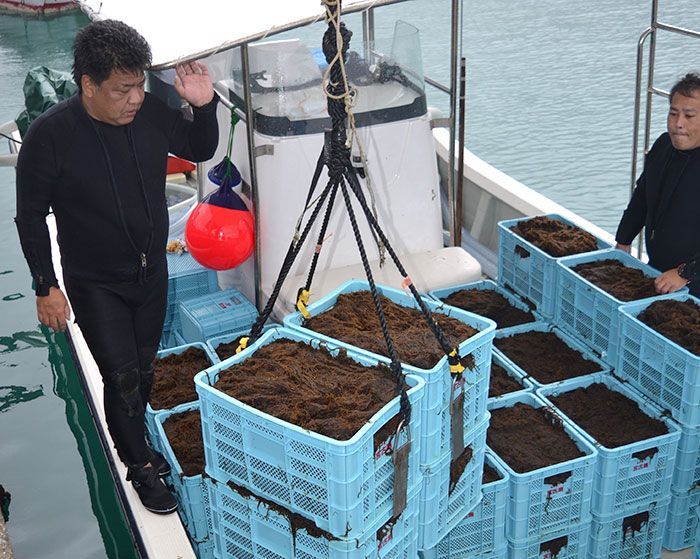Mozuku harvest begins in Miyakojima, yielding “thick, high quality seaweed, a prime result”

Fisherman offloading their harvest of mozuku – January 19, Oura Fishing port in Hirara, Miyakojima (photograph by Shinji Sano)
January 20, 2022 Ryukyu Shimpo
By Shinji Sano
Miyakojima – The earliest mozuku harvest in Okinawa has begun in Miyakojima. On January 19 at Oura Fishing Port in Hirara, Miyakojima, fishermen unloaded basket after basket of glittering, dark green mozuku seaweed. Koji Kuriyama, head of the Miyakojima Fishery Cooperative, which oversees operations, said smiling, “[The seaweed] has a great color, this is a prime result. I want to ship this out to Okinawans as soon as possible.”
The harvested mozuku has been dubbed Okinawa mozuku, a branding effort being undertaken by the Miyakojima Fishery Cooperative and the Miyakojima Marine Industry Center. Local fishermen in Hisamatsu, Miyakojima have provided the cooperative with the name “Kima-kabu”’ for the locally produced bunches of seaweed. The bunches have longer and thicker stems than regular mozuku, have no smaller stems, and have a crunchier mouth feel.
On January 19, fisherman Akiyuki Ikeda, who brought in around 1.5 tons of mozuku, said, “We were worried about the damage caused by the pumice stone and tsunami, but it was good that we were able to harvest without incident. [The mozuku] is thick and high quality.”
The mozuku harvest in Miyakojima will continue until around April. The Miyakojima Fishery Cooperative usually ships around 1,000 tons of mozuku in a regular year. Co-op president Kuriyama says,” we are forecasting shipments totaling around 1,200 tons this year. The taste is good, and we have high expectations.”
(English translation by T&CT and Sam Grieb)
Previous Article:Original copy of a 1929 Ryukyu Shimpo article describing appropriation of Ryukyuan remains soon to be available at Junkudo book fair
Next Article:Third Futenma noise lawsuit plaintiffs total 5,846 with 508 newcomers to file additional actions
[Similar Articles]
- Hijiki seaweed harvest begins
- Seaweed Food Fair held in Onna Village
- Okinawan Mozuku, and edible seaweed, is struggling with poor harvests, leading to an increase in price and 6,000 ton decrease in production
- Mozuku aquaculture interrupted by pumice stones, expected to effect national supply
- Fishery cooperative and companies create fund for protecting Mozuku seaweed in Kumejima
 Webcam(Kokusai Street)
Webcam(Kokusai Street)


